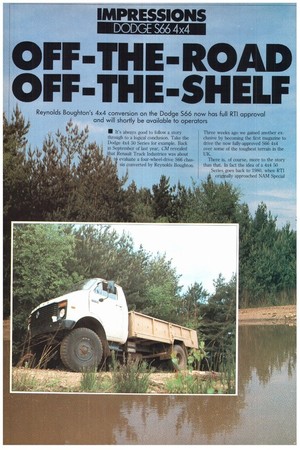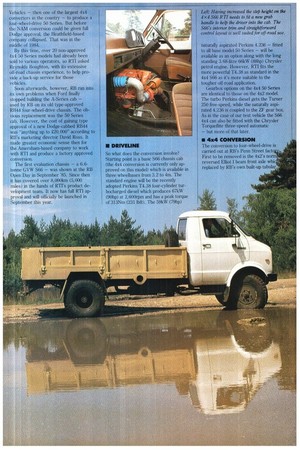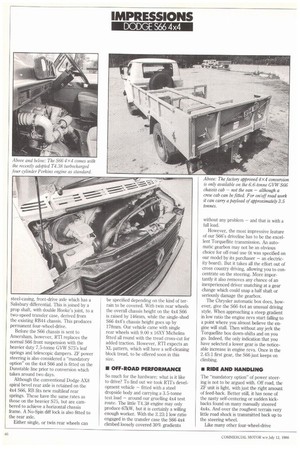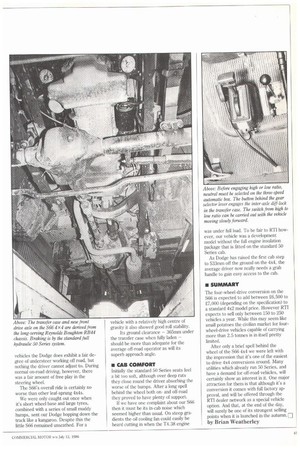FF-TH F-TN -ROAD -SHELF
Page 48

Page 49

Page 50

Page 51

If you've noticed an error in this article please click here to report it so we can fix it.
Reynolds Boughton's 4x4 conversion on the Dodge S66 now has full RT1 approval and will shortly be available to operators
• It's always good to follow a story through to a logical conclusion. Take the Dodge 4x4 50 Series for example. Back in September of last year, GM revealed
• t that Renault Truck Industries was about t evaluate a four-wheel-drive S66 chas sis converted by Reynolds Boughton.
Three weeks ago we gained another exclusive by becoming the first magazine to drive the now fully-approved 566 4x4 over some of the toughest terrain in the UK.
There is, of course, more to the story than that. In fact the idea of a 4x4 50 Series goes back to 1980, when RhI originally approached NAM Special Vehicles — then one of the largest 4x4 converters in the country — to produce a four-wheel-drive 50 Series. But before the NAM conversion could be given full Dodge approval, the Heathfield-based company collapsed. That was in the middle of 1984.
By this time, over 20 non-approved 4x4 50 Series models had already been sold to various operators, so RTI asked Reynolds Boughton, with its extensive off-road chassis experience, to help provide a back-up service for those vehicles.
Soon afterwards, however, RB ran into its own problems when Ford finally stopped building the A-Series cab — used by RB on its old type-approved RB44 four-wheel-drive chassis. The obvious replacement was the 50 Series cab. However, the cost of gaining type approval of a new Dodge-cabbed RB44 was "anything up to .220,000" according to RB's marketing director David Ross. It made p-eater economic sense then for the Amersham-based company to work with RTI and produce a factory approved conversion.
The first evaluation chassis — a 6.6tonne GVW S66 — was shown at the RB Open Day in September '85. Since then it has covered over 8,000km (5,000 miles) in the hands of RTI's product development team. It now has full RTI approval and will officially be launched in September this year. • DRIVELINE So what does the conversion involve? Starting point is a basic S66 chassis cab (the 4x4 conversion is currently only approved on this model) which is available in three wheelbases from 3.2 to 4m. The standard engine will be the recently adopted Perkins T4.38 four-cylinder turbocharged diesel which produces 67kW (90hp) at 2,600rpm and has a peak torque of 313Nm (231 Ibft). The 59kW (79hp) naturally aspirated Perkins 4.236 — fitted to all base model 50 Series — will be available as an option along with the long standing 3.68-litre 66kW (88hp) Chrysler petrol engine. However, RTI fits the more powerful T4.38 as standard in the 4x4 S66 as it's more suitable to the tougher off-road application.
Gearbox options on the 4x4 50 Series are identical to those on the 4x2 model. The turbo Perkins diesel gets the Turner 250 five-speed, while the naturally aspirated 4.236 is coupled to the ZF gear box. As in the case of our test vehicle the S66 4x4 can also be fitted with the Chrysler Torqueflite three-speed automatic — but more of that later.
• 4x4 CONVERSION
The conversion to four-wheel-drive is carried out at RB's Penn Street fact First to be removed is the 4x2's norm reversed Elliot I beam front axle wh replaced by RB's own built-up tubula steel-casing, front-drive axle which has a Salisbury differential. This is joined by a prop shaft, with double Hooke's joint, to a two-speed transfer case, derived from the existing RB44 chassis. This produces permanent four-wheel-drive.
Before the S66 chassis is sent to Amersham, however, RTI replaces the normal S66 front suspension with the heavier duty 7.5-tonne GVW S75's leaf springs and telescopic dampers. ZF power steering is also considered a "mandatory option" on the 4x4 S66 and is fitted on the Dunstable line prior to conversion which takes around two days.
Although the conventional Dodge AX8 spiral bevel rear axle is retained on the 4x4 S66, RB fits new multileaf rear springs. These have the same rates as those on the heavier S75, but are cambered to achieve a horizontal chassis frame. A No-Spin diff lock is also fitted to the rear axle.
Either single, or twin rear wheels can be specified depending on the kind of terrain to be covered. With twin rear wheels the overall chassis height on the 4x4 S66 is raised by 146mm, while the single-shod S66 4x4's chassis height goes up by 178mm. Our vehicle came with single rear wheels with 9.00 x 16XY Michelins fitted all round with the tread cross-cut for added traction. However, RTI expects an XL pattern, which will have a self-cleaning block tread, to be offered soon in this size.
• OFF-ROAD PERFORMANCE
So much for the hardware; what is it like to drive? To find out we took RTI's development vehicle — fitted with a steel dropside body and carrying a 3.5-tonne test load — around our gruelling 4x4 test route_ The little 14.38 engine may only produce 67kW, but it is certainly a willing enough worker. With the 2.23:1 low ratio engaged in the transfer case the S66 4x4 climbed loosely covered 30% gradients without any problem — and that is with a full load.
However, the most impressive feature of our S66's driveline has to be the excellent Torqueflite transmission. An automatic gearbox may not be an obvious choice for off-road use (it was specified on our model by its purchaser — an electricity board). But it takes all the effort out of cross country driving, allowing you to concentrate on the steering. More importantly it also removes any chance of an inexperienced driver snatching at a gear change which could snap a half shaft or seriously damage the gearbox.
The Chrysler automatic box does, however, give the S66 4x4 an unusual driving style. When approaching a steep gradient in low ratio the engine revs start falling to a point where you almost believe the engine will stall. Then without any jerk the Torqueflite box down-shifts and on you go. Indeed, the only indication that you have selected a lower gear is the noticeable increase in engine revs. Once in the 2.45:1 first gear, the S66 just keeps on climbing.
• RIDE AND HANDLING
The "mandatory option" of power steering is not to be argued with. Off road, the ZF unit is light, with just the right amount of feed-back. Better still, it has none of the nasty self-centering or sudden kickbacks found on many manually steered 4x4s. And over the roughest terrain very little road shock is transmitted back up to the steering wheel.
Like many other four-wheel-drive vehicles the Dodge does exhibit a fair degree of understeer working off road, but nothing the driver cannot adjust to. During normal on-road driving, however, there was a fair amount of free play in the steering wheel.
The S66's overall ride is certainly no worse than other leaf-sprung 4x4s.
We were only caught out once when it's short wheel base and large tyres, combined with a series of small muddy humps, sent our Dodge hopping down the track like a kangaroo. Despite this the little S66 remained unscathed. For a vehicle with a relatively high centre of gravity it also showed good roll stability.
Its ground clearance — 365nun under the transfer case when fully laden — should be more than adequate for the average off-road operator as will its superb approach angle.
• CAB COMFORT Initially the standard 50 Series seats feel a bit too soft, although over deep ruts they close round the driver absorbing the worse of the bumps. After a long spell behind the wheel both onand off-road they proved to have plenty of support.
If we have one complaint about our S66 then it must be its in-cab noise which seemed higher than usual. On steep gradients the oil cooling fan could easily be heard cutting in when the T4,38 engine was under full load. To be fair to RTI however, our vehicle was a development model without the full engine insulation package that is fitted on the standard 50 Series cab.
As Dodge has raised the first cab step to 533mm off the ground on the 4x4, the average driver now really needs a grab handle to gain easy access to the cab.
• SUMMARY The four-wheel-drive conversion on the S66 is expected to add between 26,500 to £7,000 (depending on the specification) to a standard 4x2 model price. However RTI expects to sell only between 150 to 250 vehicles a year. While this may seem like small potatoes the civilian market for fourwheel-drive vehicles capable of carrying more than 2.5 tonnes is in itself pretty limited.
After only a brief spell behind the wheel of the S66 4x4 we were left with the impression that it's one of the easiest to drive 4x4 conversions around. Many utilities which already run 50 Series, and have a demand for off-road vehicles, will certainly show an interest in it. One major attraction for them is that although it's a conversion it comes with full factory approval, and will be offered through the RTI dealer network as a special vehicle option. And that, at the end of the day, will surely be one of its strongest selling points when it is launched in the autumn.
by Brian Weatherley




















































































